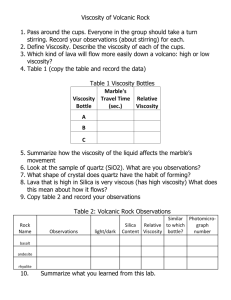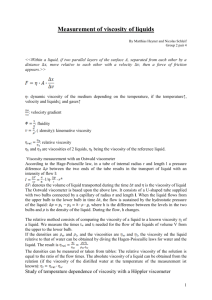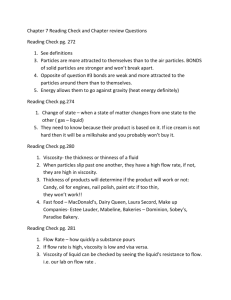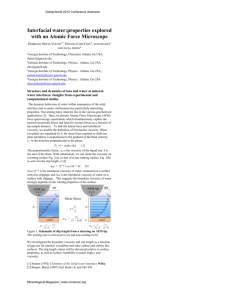LEP 1.4.04 Viscosity measurements with the falling ball
advertisement
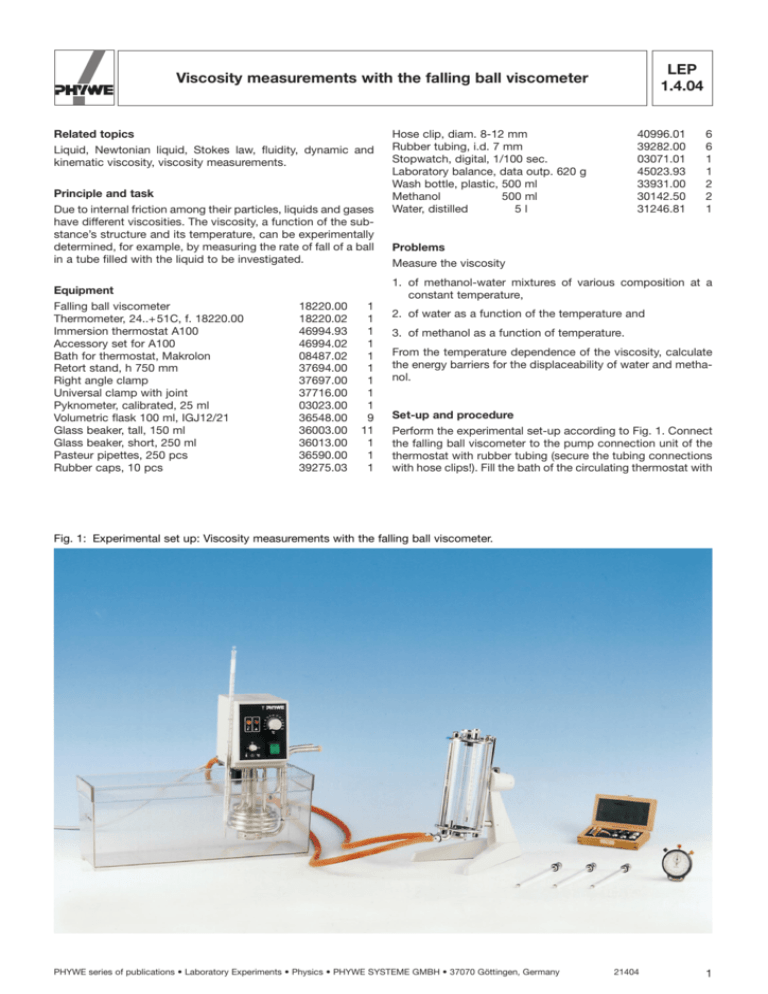
R LEP 1.4.04 Viscosity measurements with the falling ball viscometer Related topics Liquid, Newtonian liquid, Stokes law, fluidity, dynamic and kinematic viscosity, viscosity measurements. Principle and task Due to internal friction among their particles, liquids and gases have different viscosities. The viscosity, a function of the substance’s structure and its temperature, can be experimentally determined, for example, by measuring the rate of fall of a ball in a tube filled with the liquid to be investigated. Equipment Falling ball viscometer Thermometer, 24..+ 51C, f. 18220.00 Immersion thermostat A100 Accessory set for A100 Bath for thermostat, Makrolon Retort stand, h 750 mm Right angle clamp Universal clamp with joint Pyknometer, calibrated, 25 ml Volumetric flask 100 ml, IGJ12/21 Glass beaker, tall, 150 ml Glass beaker, short, 250 ml Pasteur pipettes, 250 pcs Rubber caps, 10 pcs Hose clip, diam. 8-12 mm Rubber tubing, i.d. 7 mm Stopwatch, digital, 1/100 sec. Laboratory balance, data outp. 620 g Wash bottle, plastic, 500 ml Methanol 500 ml Water, distilled 5l 40996.01 39282.00 03071.01 45023.93 33931.00 30142.50 31246.81 6 6 1 1 2 2 1 Problems Measure the viscosity 1. of methanol-water mixtures of various composition at a constant temperature, 18220.00 18220.02 46994.93 46994.02 08487.02 37694.00 37697.00 37716.00 03023.00 36548.00 36003.00 36013.00 36590.00 39275.03 1 1 1 1 1 1 1 1 1 9 11 1 1 1 2. of water as a function of the temperature and 3. of methanol as a function of temperature. From the temperature dependence of the viscosity, calculate the energy barriers for the displaceability of water and methanol. Set-up and procedure Perform the experimental set-up according to Fig. 1. Connect the falling ball viscometer to the pump connection unit of the thermostat with rubber tubing (secure the tubing connections with hose clips!). Fill the bath of the circulating thermostat with Fig. 1: Experimental set up: Viscosity measurements with the falling ball viscometer. PHYWE series of publications • Laboratory Experiments • Physics • PHYWE SYSTEME GMBH • 37070 Göttingen, Germany 21404 1 R LEP 1.4.04 Viscosity measurements with the falling ball viscometer distilled or demineralised water to avoid furring. Connect the cooling coil of the thermostat to the water supply line with tubing (secure the tubing connections with hose clips!). In addition, prepare the falling ball viscometer according to its operating instructions; calibrate it; and for each experiment fill it with the liquid to be investigated (water, methanol or methanol-water mixtures according to Tab. 1) in such a manner that it is bubble-free. Ball number 1, which is made of borosilicate glass, is appropriate for investigations in the given viscosity range. Its characteristic data can be obtained from the enclosed test certificate. After the ball has been placed in the gravity tube, first allow the viscometer to equilibrate to the selected working temperature T for approximately 10 minutes before determining 3 to 5 falling times t. Calculate the arithmetic mean of the measured values in each case. A constant working temperature of 298 K is recommended for the viscosity measurements in methanol- water mixtures (Problem a). Conduct the investigations on the temperature dependence of the viscosity of pure liquids (Problems b and c) in steps of 5 K in the temperature range between 293 K and 323 K. Parallel to this, determine the density of the respective liquids, which is required for the calculations. To do this, weigh the clean and dry pycnometer; fill it with the liquid to be investigated; fix it to the retort stand, and equilibrate it in the thermostatic water bath for approximately 15 minutes. Subsequent to bubble-free closure with the accompanying stopper and a quick external drying, reweigh the filled pycnometer. From the mass difference of the two weighings and the volume of the pycnometer, determine the density of the liquid. Rinse the gravity tube and the pycnometer thoroughly with the next liquid to be investigated each time before it is refilled. Tab. 1: Literature values for the density r and the dynamic viscosity h of methanol-water mixtures of different compositions at constant temperature (T = 298.15 K) m (CH3OH) /g 2 r h Tab. 2: Literature values for the density r and the dynamic viscosity h of water and methanol at different temperatures Water r T/K Methanol h r h /g· cm–3 /m Pa· s /g· cm–3 /m Pa· s 293.15 0.9982 1.002 0.7915 0.608 398.15 0.9970 0.897 0.7868 0.557 303.15 0.9956 0.797 0.7819 0.529 308.15 0.9940 0.726 0.7774 0487 313.15 0.9922 0.653 0.7729 0.458 218.15 0.9902 0.597 0.7690 0.425 323.15 0.9880 0.548 0.7650 0.396 Note The measurements are time consuming and take approximately 10 hours when painstakingly performed. It is therefore appropriate to divide the experiment according to the three given problems or to have them performed optionally. Another possibility is to have the complete experiment carried out on two laboratory days. Theory and evaluation The dynamic viscosity h of a liquid (1) is defined by the force F which is required to move two parallel layers of liquid both having the area A and separated by dx with the velocity dv with respect to each other. h= F dv A dv (1) By relating the dynamic viscosity to the density r of the liquid, one obtains the kinematic viscosity v (2); the reciprocal of the dynamic viscosity is designated as fluidity w (3). m (H2O) /g /g· cm–3 /mPa · s 0 100 0.9970 0.897 10 90 0.9804 1.178 20 80 0.9649 1.419 30 70 0.9492 1.581 40 60 09316 1.671 50 50 0.9122 1.577 60 40 0.8910 1.427 70 30 0.8675 1.234 (Stokes Law) 80 20 0.8424 1.025 90 10 0.8158 0.788 100 0 0.7867 0.557 For the fall of a sphere in the gravitational field of the earth the motive force Fis equal to the product of the acceleration of gravity g and the effective mass m, which can be expressed as the density difference between the sphere (r1) and the liquid (r2). 21404 v = w = h r 1 h (2) (3) A spherical particle with a radius r moves in a liquid under the influence of a force F and the viscosity w with a constant velocity v. v = F 6phr (4) PHYWE series of publications • Laboratory Experiments • Physics • PHYWE SYSTEME GMBH • 37070 Göttingen, Germany R LEP 1.4.04 Viscosity measurements with the falling ball viscometer Fig. 2: Dependence of the viscosity h of the methanol-water system on the composition described by the mass traction w at constant temperature (T= 298 K). F = m’ g = 4 p r3 g ( r1 – r2) 3 (5) The correlation (6) for the calculation of the viscosity, which is derived from (4) and (5), is only considered as the limit law for expanded media (the radius can be neglected with respect to that of the gravity tube); otherwise, the relationship can be approximated by corrections (Ladenburg Correction). 2 g r2 ( r1 – r2) h = gv (6) (7) (t = rate of fall of the sphere for a measuring distance of s = 100 mm) The density r2 of the liquid at temperature T which is contained in eqn. (7), can be calculated using the relationship m r2 = V which the composition of methanol-water mixtures are expressed as the mass fraction w (9.1) or the mole fraction x (9.2) is an expression of the non-ideal behaviour of the liquids. It correlates to additional mixing phenomena such as mixing volume (volume contraction) and mixing enthaIpy. w1 = m1 m1 + m2 (9.1) ( wi= mass fraction, rni = mass of the substance i ) For commercial falling ball viscometers with sets of calibrated spheres, the constants in equation (6) are combined with the apparative factors to form the spherical constant K; this makes the calculations much simpler: h = K t ( r1 – r2) Fig. 3: Dependence of the viscosity h of the methanol water system on the composition described by the mole fraction x at constant temperature (T= 298K). m1 n1 M1 x1 = = n1 + n2 m1 m2 + M1 M2 (9.2) (wi = mole fraction, ni quantity of substance, mi = mass of the substance i, Mi = molar mass of substance i) For many liquids the reduction of the viscosity with temperature is described by an empirically determined exponential function (10). 1 h = w = Ce – E RT (10) ( R = 8.31441 J· K–1· mol–1, universal gas constant) (8) ( m = mass of the liquid; V = volume of the pycnometer) using the experimentally determined pycnometer data or alternatively that obtained from Tables 1 and 2. The viscosity is a function of the structure of the system and the temperature. The alteration in the measured viscosity in In this relationship which is analogous to the Arrhenius equation, C represents a system-dependent constant; E is an expression of the molar energy which is required to overcome the internal friction. This activation energy can be determined from the slope obtained by the linear relation (10.1) between In h and 1/T (Fig. 4). In h = E 1 · – In C. R T PHYWE series of publications • Laboratory Experiments • Physics • PHYWE SYSTEME GMBH • 37070 Göttingen, Germany (10.1) 21404 3 R LEP 1.4.04 Viscosity measurements with the falling ball viscometer Data and results The experimentally determined viscosities are presented graphically in the Figures 2 to 4 as a function of the composition of the methanol-water mixtures or of the temperature. Fig. 4: Temperature dependence of the dynamic viscosity h of water (o) and methanol (+), respectively. The following values are determined for the slopes of the linear relationships between In h and 1/T, which are obtained by linear regression analysis: D (ln h) /D (1/T) = 1.799 · 103 K (H2O) and D (ln h) /D (1/T) = 1.134 · 103 K (CH3OH). Substituting these values in Eq. (10.1), the corresponding energy barriers are obtained E = 14.8 kJ· mol–1 (H2O) and E = 9.4 kJ· mol–1 (CH3OH). The energy barriers, which are obtained by using the literature values for h (given in Table 2), are E = 15.9 kJ · mol–1 and E = 11.1 k J· mol–1. 4 21404 PHYWE series of publications • Laboratory Experiments • Physics • PHYWE SYSTEME GMBH • 37070 Göttingen, Germany


